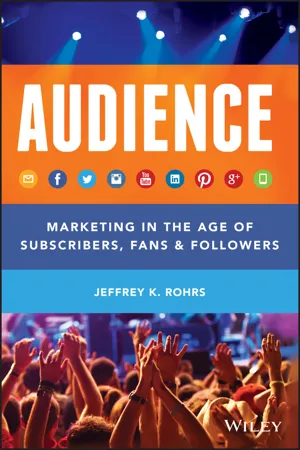
- English
- ePUB (mobile friendly)
- Available on iOS & Android
About this book
AUDIENCE
Most companies are still taking one step forward and two steps back in their customer relationships because they don't understand how to build and engage a long-term online audience. The new job every marketer must learn is "Proprietary Audience Development." AUDIENCE is a manifesto—a "call to arms"—that every marketer can deliver to their C-Suite in order to permanently put an end to "spammy" digital marketing and social media strategies that may gain a few quick sales but lose a long-term audience.
This powerful mandate challenges all companies to treat their email, mobile, and social audiences like the corporate assets they are. In AUDIENCE, author Jeff Rohrs establishes The Audience Imperative for every company: to use your paid, owned, and earned media to not only sell in the short-term but also increase the size, engagement, and value of proprietary audiences over the long-term. To gain a lasting advantage over your competition, look no further than your email, Facebook, Google, Instagram, mobile app, SMS, Twitter, website, and YouTube, where you can start building audiences that last.
Through research data and case studies, this book details how marketers can gain a competitive advantage with proven strategies, including how to:
- Embrace "Hybrid Marketing" to squeeze more value from "Fossil Fuel Marketing" (i.e., paid media)
- Build "renewable energy sources" (owned email, mobile, and social audiences) that provide long-term competitive advantage
- Create your own Proprietary Audience Development strategy
- Market with the Red Velvet Touch: Serve the individual, honor their preferences, deliver relevant content, surprise them with access, and delight them with your company's humanity
- Test and evolve your efforts on an ongoing basis
Every company needs audiences to survive. They are the source of new customers and more profitable relationships. It's time to restructure your marketing efforts to serve your most important asset. Master the art and the science of Proprietary Audience Development.
Frequently asked questions
- Essential is ideal for learners and professionals who enjoy exploring a wide range of subjects. Access the Essential Library with 800,000+ trusted titles and best-sellers across business, personal growth, and the humanities. Includes unlimited reading time and Standard Read Aloud voice.
- Complete: Perfect for advanced learners and researchers needing full, unrestricted access. Unlock 1.4M+ books across hundreds of subjects, including academic and specialized titles. The Complete Plan also includes advanced features like Premium Read Aloud and Research Assistant.
Please note we cannot support devices running on iOS 13 and Android 7 or earlier. Learn more about using the app.
Information
Part I
The Audience Imperative
Chapter 1
Audiences as Assets: Think Like The Boss
The Boss Is Worried
- From 2008 to 2012, daily newspaper circulation dropped 26.6 percent in the United Kingdom and 14.9 percent in the United States.2
- Twenty-nine percent of TV viewing is time-shifted thanks to DVRs, VOD, and Web-streaming platforms (and 41 percent of recorded shows go unwatched).3
- By 2020, the average consumer will own 50 Internet-enabled devices.4
Table of contents
- Cover
- Contents
- Title
- Copyright
- Dedication
- Foreword
- Introduction: Why AUDIENCE?
- Part I: The Audience Imperative
- Part II: The Audience Channels
- Part III: The Audience Roadmap
- Conclusion
- Acknowledgments
- Index